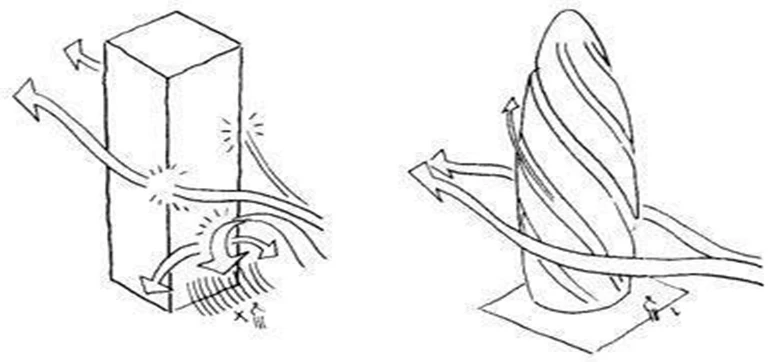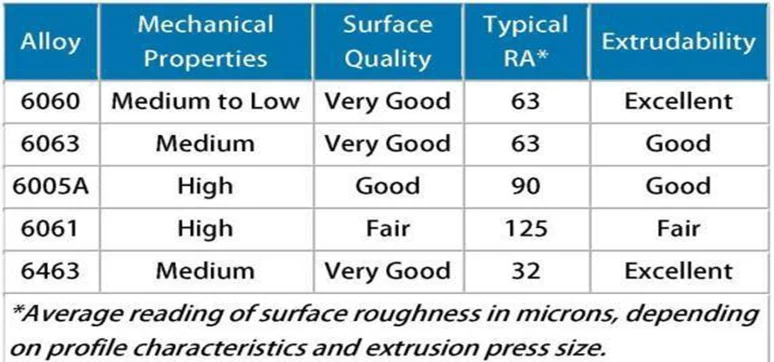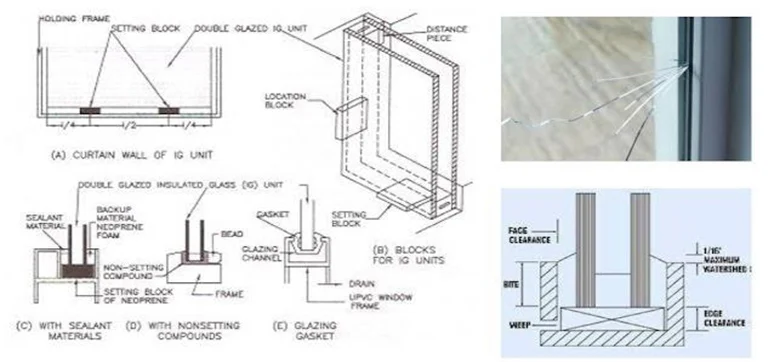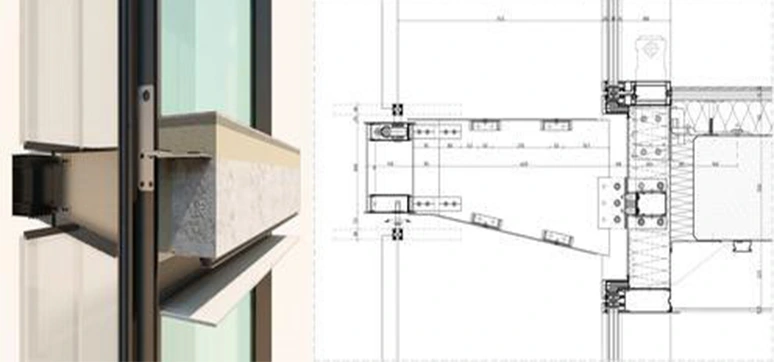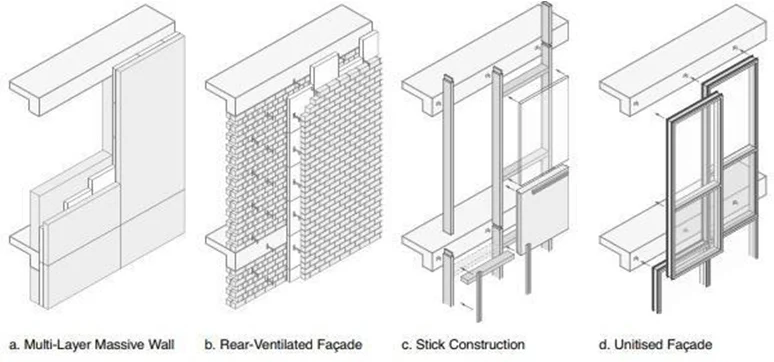The façade shall function structurally. The design loads imposed on façade infills and substructures shall transmit safely to the underlying primary structure, accommodating various differential movements. Understanding the structural behavior of the façade is essential for façade designers and engineers to ensure the sturdiness and resiliency of the entire building enclosures.
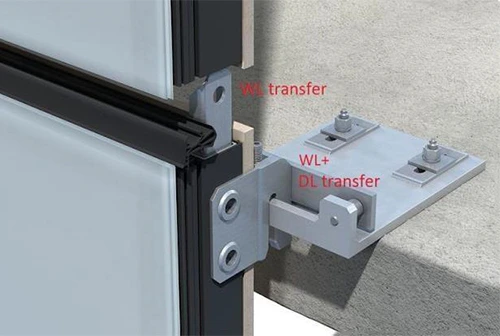
Ensuring the structural performance of a building façade is vital in design and construction. Façade designers must analyse loads like wind, snow, and seismic forces, selecting materials that balance aesthetics with structural strength. Attention to connection design accommodates movements such as thermal expansion while integrating expansion joints controls stress build-up. Testing and simulations refine façade behavior under various conditions, and code compliance ensures safety standards. Collaborative efforts between architects, structural engineers, and façade engineers seamlessly integrate aesthetic and structural considerations. Long-term maintenance and quality control during construction and effective documentation and communication contribute to creating a resilient and aesthetically pleasing building envelope.
Load Transfer and Support
The façade shall be designed to transfer various loads, including dead loads (self-weight), live loads (occupant loads, wind loads, snow loads), and thermal loads, to the building’s structural system. The façade support includes columns, beams, brackets, and anchors, which provide the necessary structural support and ensure load transfer to the main structure.
The design of a building façade involves critical considerations for load transfer and support, ensuring the structure’s safety and stability. Dead loads, representing the weight of façade components, necessitate an efficient structural system for proper distribution – Live loads, including occupant, wind, and snow loads, demand façade support elements capable of safely transferring these dynamic forces. Thermal loads arising from temperature variations require mechanisms like expansion joints to accommodate material movements. Façade support elements like columns, beams, brackets, and anchors play a vital role, requiring careful consideration of material properties and load distribution. The load transfer path must be designed to avoid localised stresses, and material selection should prioritise strength and durability. Compliance with building codes is essential, contributing to a well-designed façade that enhances aesthetics while ensuring safe load transfer for overall structural stability and longevity.
Structural Stability
The façades contribute to the overall stability of the building by resisting lateral forces such as wind and seismic loads. In conjunction with the building structure, the façade system forms a stable and interconnected system that can resist external forces and maintain structural integrity.
The exterior building envelope façades are pivotal for a building’s structural stability, safeguarding against wind and seismic forces. Building envelopes are carefully designed, detailed, and engineered in tall structures to endure significant wind pressures.
The façade system, encompassing cladding and glazing, effectively distributes wind loads to the building structure. Façades absorb and dissipate seismic forces in earthquake-prone areas, working harmoniously with structural elements. The building envelope is crucial in even load distribution across the structure, ensuring balance during adverse conditions. Their seamless integration with the building structure enhances stability, preventing potential failures. Material strength and durability are imperative, contributing to the long-term resilience of buildings.
Wind Load Resistance
The façades are designed to withstand wind pressures and transmit these loads to the building structure. The façade’s shape, orientation, surface area, and choice of materials influence wind load distribution and resistance. Façade engineers employ techniques such as wind tunnel testing, computational fluid dynamics (CFD), and structural analysis to determine the wind load effects and design appropriate façade systems.
Designing wind-resistant façades is crucial in engineering, especially in windy areas. Influencing factors include building shape, orientation, surface area, and material choice. Irregular shapes and prevailing winds impact wind pressures, while larger surface areas expose buildings to higher forces. Heavy materials offer better resistance, sometimes. Adherence to wind load codes and standards is vital. Design considerations involve incorporating wind-resistant features, pressure equalisation systems, and regular maintenance. A holistic approach ensures effective façade design, crucial for tall or complex structures facing significant wind forces.
Thermal Expansion and Contraction Façade materials, especially metals and glass, undergo thermal expansion and contraction due to temperature variations. Façade engineering considers the coefficients of thermal expansion of materials and incorporates appropriate expansion joints and detailing to accommodate these movements and prevent structural damage.
Façade engineering is crucial for buildings, especially metals and glass, as they undergo thermal expansion and contraction due to temperature variations. Materials expand when heated and contract when cooled, with varying coefficients of thermal expansion (CTE). Metals like aluminium and steel have higher CTE, necessitating careful engineering. Glass has a lower CTE, is brittle, and requires precise management. Engineers employ expansion joints, detailed connections, and compatible material selection to accommodate thermal movements, preventing structural damage. Challenges arise with rapid temperature changes, demanding comprehensive solutions, often aided by computer modeling. Proactive façade engineering ensures longevity and structural integrity.
Structural Materials and Connections The choice of façade materials, such as concrete, stone, granite, steel, aluminium, glass, or composite panels, significantly affects the structural behavior of façades. Façade engineers carefully select materials based on their strength, durability, weight, and compatibility with the building structure. The connections between façade elements and the main structure, including anchors, fasteners, and support systems, must be designed to ensure proper load transfer and structural stability.
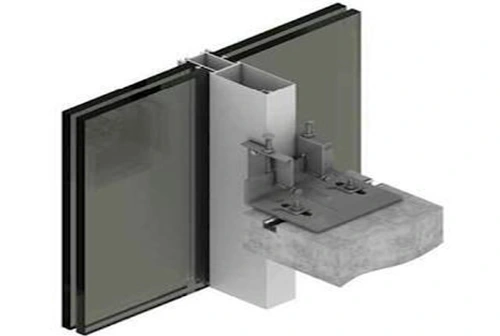
For example, the aluminium alloy 6061 is a heat-treatable alloy that offers excellent mechanical properties, including high tensile strength. It has a typical tensile strength range of 276-310 MPa (40,000-45,000 psi), depending on the temper (condition) of the material. This alloy is often used in structural applications, such as building frames, aerospace components, and automotive parts, where strength is critical.
On the other hand, aluminium alloy 6005 is a non-heat-treatable alloy with good formability and weldability. It typically has a slightly lower tensile strength compared to 6061. The typical tensile strength range for alloy 6005 is around 207- 276 MPa (30,000-40,000 psi). This alloy is commonly used in architectural applications, such as window frames, curtain walls, and extruded profiles.
The selection of façade materials and the design of connections are vital for a building’s performance and safety. Façade connections, including anchors, fasteners, and support systems, must be designed, engineered, and detailed to ensure proper load transfer, accommodate movement, and resist corrosion. A well-coordinated approach involving collaboration between architects, structural engineers, and façade specialists is essential. The summary underscores the importance of balancing structural integrity, aesthetics, and functionality for an optimal façade solution that meets technical and design requirements.
Integration with Building Structure
Façade engineering involves close collaboration with structural engineers to integrate the façade system seamlessly with the building structure. Façade loads and reactions are accurately determined, and appropriate design measures are taken to ensure compatibility and structural performance between the façade and the main structure.
Integrating façade systems with building structures is vital in architectural and structural design. Façade engineering, focusing on the building envelope, requires collaboration between engineers. Key considerations include load analysis, ensuring structural performance, compatibility, and detailing for the interface, accounting for thermal and movement factors, and material selection. Adequate structural support systems, testing, and quality assurance are essential. Addressing building movement & complying with local codes ensures a seamless integration that enhances aesthetics while ensuring safety, durability, and long-term performance. Effective collaboration between façade and structural engineers is pivotal for success in this intricate process.
Summary
Overall, the structural behavior of façades explores the intricate considerations in designing and engineering building façades, highlighting their pivotal role in a structure’s overall integrity and aesthetic appeal. Emphasizing load transfer and support underscore the efficient transmission of dead, live, and thermal loads to the building’s structure, focusing on careful material selection and adherence to building codes for a balanced and safe façade design. Structural stability is addressed, emphasising how façades contribute to a stable, interconnected system that resists lateral forces like wind and seismic loads.
Wind load resistance is crucial, and the factors influencing façade design include shape, orientation, surface area, and material choice. Techniques like wind tunnel testing and computational fluid dynamics ensure effective resistance. Thermal expansion and contraction considerations highlight the need for engineers to employ expansion joints and compatible materials to prevent structural damage due to temperature variations.
The selection of façade materials & connections is deemed vital, with concrete, steel, aluminium, glass, and composite panels influencing structural behavior. Integration with the building structure requires close collaboration between façade and structural engineers, addressing load analysis, compatibility, and thermal factors.
Proactive façade engineering approaches, including effective communication, adherence to local codes, comprehensive testing, and compliance with safety standards, are underscored as essential for the long-term resilience of buildings, summarising the multidisciplinary approach needed for optimal façade solutions.
